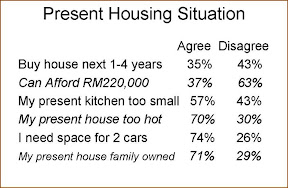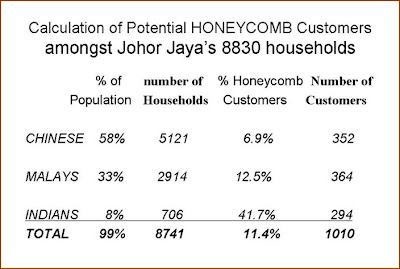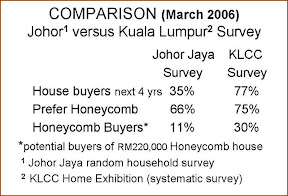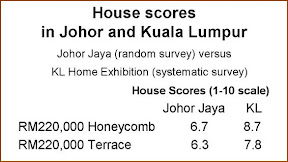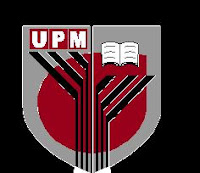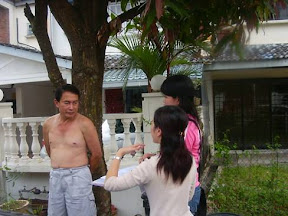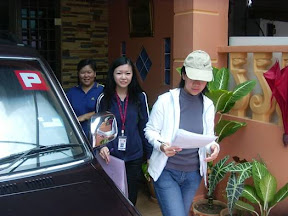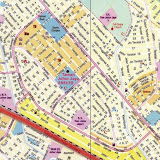Bandar Baru Uda Survey Survey
UNIVERSITI PUTRA MALAYSIA HONEYCOMB HOUSING versus CONVENTIONAL HOUSING… …20 times more potential buyers for Honeycomb UPM SURVEY AT FRONT OF STATE GOVERNMENT OFFICE JOHOR BARU, 11-14 SEPTEMBER, 2006 Mohd Peter Davis, Bukryman Sabri and Nurizan Yahaya Universiti Putra Malaysia and Mazlin Ghazali Arkitek M. Ghazali Report Published 29 September 2006 HONEYCOMB H OUSIN G CONCEPT The UPM Survey Team at work at front of state government office Johor Baru, 11-14 September, 2006. JOHOR BARU HOUSING SURVEY 11-14 SEPTEMBER 2006 HONEYCOMB or CONVENTIONAL HOUSING? UPM SURVEY at FRONT OF STATE GOVERNMENT OFFICE JOHOR BARU, 11-14 SEPTEMBER 2006 IN BRIEF Honeycomb® is a unique Mal aysian housing invention (international patents pending) and gaining wide acceptance from potential house buyers in consumer surveys and from housing professionals in exhibitions and seminars. It has been recently adopted by the Sarawak Government for the Ninth Malaysia Plan. “Thermal Comfort Honeycomb Housing: the Affordable Alternative to Terrace Housing” is the title of a UPM popular science book (2006) and describes how this invention was developed over many years by Kuala Lumpur based Arkitek M. Ghazali in collaboration with the Cool House research conducted by Universiti Putra Malaysia. Honeycomb housing differs dramatically from terrace housing by clustering cool, modern houses with their own garden around small shady parks. This town planning design slows the traffic without speed humps and recreates a safe outdoor environment reminiscent of Malay kampungs and rural towns. The Honeycomb concept offers a new urban lifestyle fostering three generation friendly neighbourhoods where children are the concern of the whole community. Even very young children are free once again to play outdoors together, cycle safely to school and the shops and independently explore and enjoy the world around them as they get older, liberating their ‘taxi driver’ parents. This consumer survey of mainly Johor State Government employees marks a breakthrough. It reports for the first time the response to a complete range of 8 types of Honeycomb apartments and Honeycomb houses priced from RM 42,000 to RM 250, 000 and compares each of them to identically priced conventional apartments, terrace houses and semi-Ds. The survey reveals an overwhelming preference for the Honeycomb range of apartments and houses and proves they are affordable to 100% of potential home buyers. Should Honeycomb housing now be implemented throughout Malaysia? We think so but let the evidence below and in the detailed report speak for itself:i UNIVERSITI PUTRA MALAYSIA Contact: Mohd Peter Davis, Visiting Scientist, Institute of Advanced Technology, Universiti Putra Malaysia. Off: 603-8946-7564 H/p: 012-335-1938 mohd_peter@ hotmail.com Mohd Peter Davis, Bukryman Sabri and Nurizan Yahaya and Mazlin Ghazali, Arkitek M. Ghazali HONEYCOMB A PARTMENTS (FROM RM 42,000) HONEYCOMB TERRACE (FROM RM 130,000) ii UNIVERSITI PUTRA MALAYS IA HONEYCOMB or CONVENTIONAL HOUSING… …20 times more potential buyers for Honeycomb UPM SURVEY at FRONT OF STATE GOVERNMENT OFFICE JOHOR BARU, 11-14 SEPTEMBER 2006 Mohd Peter Davis, Bukryman Sabri and Nurizan Yahaya Universiti Putra Malaysia and Mazlin Ghazali Arkitek M. Ghazali INTRODUCTION “Thermal comfort Honeycomb housing” a book recently published by Universiti Putra Malaysia, in close collaboration with Arkitek M. Ghazali (1) describes 17 years of pioneer research to develop an affordable and environmentally friendly alternative to terrace housing. Cluster houses consisting of 2, 3, 4 or 6 units, rather than long rows of terrace houses, are arranged like bungalows in a honeycomb pattern around small neighbourhood parks planted with fruit bearing rainforest trees to shade the roads and provide food for birds and small wildlife. The honeycomb arrangement, offering the same or higher density than terrace housing, reduces the roads and through traffic, discouraging burglary and making the area outside the home much safer for children and more sociable for the residents. This new Malaysian architectural concept has been widely presented to housing industry seminars and displayed at Inventors exhibitions and Home Ownership campaigns. Scientific surveys conducted by UPM at these events, have shown over 90% acceptance for the Honeycomb concept and a strong demand (80% ) amongst potential house buyers. This new housing form, representing the third wave of Malaysian housing following traditional kampong housing and post Independence urban terrace housing, has recently been accepted by the Sarawak Government for State housing under the Ninth Malaysia Plan (2). Despite this enthusiasm for Honeycomb amongst potential house buyers, including professionals in the housing industry, Developers are still cautious. Although Developers generally like Honeycomb housing since it makes better use of land and saves on infrastructure costs, no one wants to be the guinea pig! This is understandable. The price of failure for a housing Developer is very severe. Developers fear that the Government authorities will not approve of such a radical departure from terrace housing which is the predominant housing form in Malaysia and tried and tested over the last 50 years. Let someone else be the first to try Honeycomb; then we will follow! Faced with this industry reluctance the ‘somebody else’ had to be State Governments, a major client for housing in Malaysia. 1 Arkitek M.Ghazali together with UPM has therefore embarked on a patient campaign to ‘win hearts and minds’ for Honeycomb housing amongst Authorities, S tate G overnments and their Government Linked Companies. Seminars to Authorities and housing professionals have proved every effective. This basic education work with key housing professionals has been reinforced by extensive market surveys conducted by Universiti Putra Malaysia amongst all layers of the house buying public to scientifically measure the acceptance level for Honeycomb housing. Johor Jaya Survey, April 2006 In a pioneer survey in Johor, UPM was able reassure the Developer that the proposed Honeycomb project in a predominantly Chinese area did not conflict with Feng Sui beliefs (3). The study also made an important step forward by estimating the number of potential buyers of the proposed RM220, 000 Honeycomb house compared to a terrace house of similar size and price. This random survey of 8830 households in Johor Jaya was able to conclude that 1010 potential customers existed for the Honeycomb house, some three times more than for the equivalent terrace house. Kuantan State Government Survey, July 2006 Similar survey and analytical techniques were used in a very large survey of 513 Government S ervants and Private Employees in the foyer of Government offices in Kuantan to determine the number of potential buyers of a range of five Honeycomb houses priced between RM120,000 and RM250,000 versus matching terrace houses. The Kuantan survey was designed to answer two simple questions of great commercial importance to PASDEC, the development company owned by the Pahang State:1. Which type of house, Honeycomb or Terrace, do Kuantan residents prefer? 2. How many potential Honeycomb buyers amongst the respondents? The results showed that 95% of respondents preferred Honeycomb housing and that 60% wanted to buy a Honeycomb house within 1 to 4 years. However, half the potential Honeycomb buyers could not afford the RM120, 000 price of the cheapest house in the survey. Johor State Government Survey, September 2006 The survey presented in this report covered a much wider price range between RM42,000 and RM250,000 and included for the first time a range of newly designed Honeycomb apartments. The survey was conducted outside the Johor State Government Office Building and was met with an enthusiastic response from Government S ervants and members of the public. In particular the survey was designed to determine the preference for Honeycomb houses and apartments and their affordability amongst different categories of public servants. The response amongst the one million Government Servants is a key indicator of how the whole house buying public in Malaysia will respond to Malaysia’s new invention, Honeycomb housing. 2 METHODS Survey Techniques The type of survey conducted is always a key consideration. A random survey of the target group is by far the best type of survey since it quite accurately represents the whole group. However, in this case ‘Opportunity’ survey was chosen where Government Servants during working hours and members of the public were encouraged to view a small housing exhibition outside the Johor S tate Government Building and then participate in the survey. This type of survey is frequently used in Supermarkets, Public Transport centres and on busy streets and is logistically much easier than a random survey and yields many more respondents from a wider population in a short time. What it lacks in randomness is partly compensated by larger numbers of diverse respondents. An opportunity survey was particularly useful in this case for measuring the public perception of Honeycomb housing as a completely novel form of housing since respondents could each view a model and the drawings of a range of Honeycomb apartments and houses versus a matching set of conventional housing. Respondents were able to view the exhibition, ask questions, form opinions and complete a detailed questionnaire in a very short time (10 to 20 minutes). Universiti Putra Malaysia is pioneering and continuously improving this rapid Opportunity survey technique as a general ‘Citizen Survey’ method, encouraging busy people to willingly participate in surveys of national importance which can be processed and published within a few weeks. The opportunity survey was conducted by 4 UPM student enumerators and a UPM team leader from 8am to 5pm on four days (11-14 S eptember 2006) and generated 249 respondents. The 190 Government servant respondents represented a sizable portion (about 16% ) of the staff working of the Johor State Government building and, as a bonus group, 59 members of the public attending Government Offices. Those who showed interest in the exhibited housing model and displays outside the Government Offices were encouraged by a friendly Univ ersity team to complete a questionnaire. Respondents were asked to select an apartment or house they could afford in 8 price categories (RM 42k, 60k, 80k apartments and RM 130k, 160k, 190k, 220k and RM 250k houses). Respondents were then shown site and layout drawings of the appropriately priced Honeycomb apartment or house and the corresponding conventional apartment or house at the same price. The University requested permission to conduct the survey from the Johor Chief Secretary of Johor who kindly approved. The UPM survey team of 4 experienced young graduates lead by a UPM lecturer was issued with a UPM ‘To whom it may concern’ letter (See Appendix) seeking the cooperation of staff. The good response (249 fully completed forms with no bad data) in 4 days of sampling was made possible by the cooperation of the guards, the relaxed conditions outside the Government Offices and the interesting Honeycomb housing display which attracted curiosity and enthusiasm. After viewing the exhibition and asking questions, respondents were asked to complete a Malay language questionnaire of 30 simple, tick the box questions. Apart from social demographic questions most questions required ticking the appropriate box, Strongly agree, Agree, Disagree, Strongly disagree. Interview Techniques Statistical Analysi s Back at UPM, the responses to the questionnaire statements were punched into a standard SPSS computer program “Statistical Package for the Social Sciences”. Frequency tables were prepared and further cross tabulation analyses were performed within the same statistical package. 3 Table 1 Table 2 Table 3 RESULTS & DISCUSSIONS The 249 respondents comprised of 76% Government Servants (190) and 24% members of the public (59) who were attending Government offices. Their response to 6 of the questions is shown in Table 1. The key finding is that 95% in this Johor survey preferred Honeycomb housing compared to conventional housing. This overwhelming preference for Honeycomb amongst predominantly Government Servants was almost identical to a similar survey in Kuantan in July 2006. Similar also to the Kuantan survey, there was an extremely high level of satisfaction with their job (98% overall) and with living in Johor Baru (94% ). Some 82% got to work in under 30 minutes and 57% considered the Public Transport in Kuantan to be good. Respondents were asked to select their preferred location to buy a house/ apartment from 7 current development locations around Johor Baru. 84% preferred either Nusajaya (58% ) or Taman Impian Emas (26% ). Only 6% preferred Mount Austin, a major development in Johor Baru. 95% Prefer Honeycomb High Satisfaction with Job and JB Nusajaya Top Preference Potential Buyers Some 164 (66% ) of respondents preferred honeycomb AND wanted to buy a house/apartment within 4 years, making them potential Honeycomb buyers compared to only 8 for conventional housing (Table 2). The main finding of this Johor report is that Honeycomb housing has 20 times more potential buyers than conventional apartments, terrace houses and semi-Ds. This outstanding preference for Honeycomb supports an almost similar finding from the Kuantan survey. Clearly, developers in both States need to take note that Honeycomb housing is capturing the imagination of the house buying public and could replace the present market for terrace house and low-medium cost apartment. Honeycomb Scores High A novel scoring system on a 1 to 10 scale has been developed to compare Honeycomb housing with terrace housing based on responses to questions on a satisfaction scale (highly satisfied 10 points, satisfied 7 points, dissatisfied 4 points and highly dissatisfied 1 point). When rated by 249 respondents on 5 criteria, Honeycomb scored 42% higher (8.47 out of 10) compared to terrace and conventional apartments (5.98 out of 10) Table 3. 4 Table 4 Table 5 Table 6 Table 7 Honeycomb Affordability A wealth of information on housing affordability was able to be extracted from this quite simple housing survey taking up just 10 to 20 minutes of the respondents’ time. The affordability of the 3 Honeycomb apartments (Priced RM42k, 60K and 80K) and the 5 Honeycomb houses (priced RM130k, 160k, 190k, 220k and 250k) is shown in Table 4, according to Government category and the private sector. All 164 potential Honeycomb buyers could afford either a house or apartment. None were excluded by price. The average affordability and the number of potential Honeycomb buyers for Category A, B, C and D Government servants is shown in Table 5. The affordability amongst the Private sector group is between category A and B government servants. The housing affordability of the different age groups which determines the type of apartment or house they can buy, is shown in Table 6. The average affordability by age group steadily rises from around RM93,500 for the potential buyers in their twenties to RM132,000 in the fifties age group (Table 7). Developers should compare these rather low affordability levels with the apartments and houses they are building. For the first time this survey proves that Honeycomb housing is affordable to all categories of Government servants and Private Sector employees in the survey. Thus it would seem fair to conclude that the whole Malaysian working population can afford the range of Honeycomb housing presented in the Johor survey. 5 Table 8 Table 9 Table 10 Government Loan or Bank Loan Of the 164 potential Honeycomb buyers, 52% intended to use their Government housing loan entitlement whilst 40% would rely on Bank loan, as shown in Table 8. Preferred Location Some 90% of potential Honeycomb buyers preferred either Nusajaya or Taman Impian Emas. The breakdown by affordability clearly showed that all income groups were happy to live in thes new development areas, although they are some distance from Johor Baru (Table 9). Demographic Data The Basic data of the 249 respondents of the Johor Baru survey are shown in Table 10. 6 CONCLUSION The data presented in this report by Univ ersiti Putra Malaysia, supports and reinforces earlier Honeycomb housing surveys by the University. • Honeycomb Housing is overwhelmingly preferred by the house buying public compared to terrace housing and conventional apartments. • There are 20 times more potential Honeycomb buyers than for conventional apartments and terrace housing of matching features and price. • The range of Honeycomb apartments and houses from RM42,000 to RM250,000 are affordable to all income groups. The Malaysian invention Honeycomb Housing is highly acceptable as the next generation of Malaysian housing, following the present generation of terrace housing which superseded traditional kampong housing. Indeed the UPM Honeycomb housing surveys are equivalent to asking the public “Which do you prefer, horses or cars!” 7 ACKNOWLEDG MENTS The authors would like to thank the UPM Survey team members for their excellent and enthusiastic work :• Khairunesa Isa • Mohd Salleh Bacho • Mohd Ridzuan Hassim • Mohamed Azrul Syam Mohd Yusof We extend our warm regards to the 249 Johor Baru residents for their willing cooperation in this survey and hope that one day soon they and their families will enjoy liv ing in a Honeycomb Township BIBLIOGRAPHY • Mohd Peter Davis, Mazlin Ghazali and Nor Azian Nordin (2006) in ‘Thermal Comfort Honeycomb Housing, the Affordable Alternative to Terrace Housing’, Hardback 186 pages, published by Universiti Putra Malaysia, Serdang. Malaysia. • Mohd Peter Davis, Bukryman Sabri and Nurizan Yahaya (2006) ‘Does Honeycomb housing conflict with Feng Sui beliefs?’ Universiti Putra Malaysia, Report 13 April. • Mohd Peter Davis, Bukryman Sabri and Nurizan Yahaya (2006) Honeycomb Housing or Terrace Housing…which does Kuantan prefer? Universiti Putra Malaysia Report 9 August. 8 (RM 42,000) iii (RM 42,000) iv (RM 130,000) v (RM 130,000) vi (RM 250,000) vii (RM 250,000) viii
Posted by
Mazlin Ghazali
at
Saturday, November 15, 2008
1 comments
![]()








